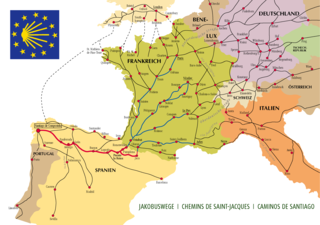
The Camino de Santiago, or in English the Way of St. James, is a network of pilgrims' ways or pilgrimages leading to the shrine of the apostle James in the cathedral of Santiago de Compostela in Galicia in northwestern Spain, where tradition holds that the remains of the apostle are buried.

Ponferrada is a city of Spain, located in the autonomous community of Castile and León. Ponferrada, the second most populated municipality of the Province of León, is also the capital city of El Bierzo, the only comarca recognized as an administrative entity by law in the region.
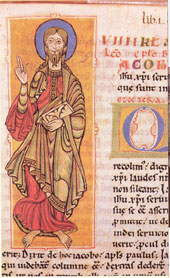
The Codex Calixtinus is a manuscript that is the main witness for the 12th-century Liber Sancti Jacobi, a pseudepigraph attributed to Pope Calixtus II. The principal author or compiler of the Liber is thus referred to as "Pseudo-Calixtus", but is often identified with the French scholar Aymeric Picaud. Its most likely period of compilation is 1138–1145.
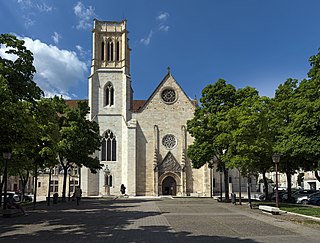
Agen Cathedral is a Roman Catholic cathedral located in Agen, Lot-et-Garonne, Aquitaine, France. It is dedicated to Saint Caprasius. It was built in the 12th century as a collegiate church and is a UNESCO World Heritage Site.
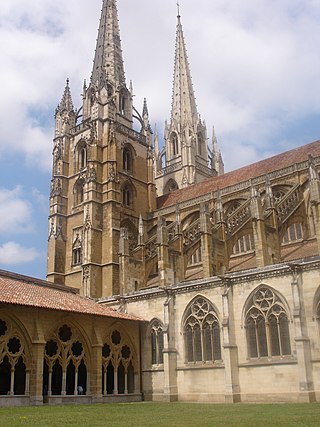
The Cathedral of Saint Mary of Bayonne or the Cathedral of Our Lady of Bayonne, commonly known as Bayonne Cathedral, is a Roman Catholic church in the town of Bayonne, France. It is the seat of the former Bishops of Bayonne, now the Bishops of Bayonne, Lescar, and Oloron. The cathedral is in the Gothic architectural tradition.

The French Way follows the GR 65 and is the most popular of the routes of the Way of St. James, the ancient pilgrimage route to Santiago de Compostela in Galicia, Spain. It runs from Saint-Jean-Pied-de-Port on the French side of the Pyrenees to Roncesvalles on the Spanish side and then another 780 km on to Santiago de Compostela through the major cities of Pamplona, Logroño, Burgos and León. A typical walk on the Camino francés takes at least four weeks, allowing for one or two rest days on the way. Some travel the Camino on bicycle or on horseback.

Christianity has a strong tradition of pilgrimages, both to sites relevant to the New Testament narrative and to sites associated with later saints or miracles.

In Spain, the legal designation Conjunto histórico is part of the national system of heritage listing. It is applied to buildings in a given locality. It is typically used to protect complete villages, such as Peñaranda de Duero, or historic quarters of towns such as Avilés.

UNESCO designated the Routes of Santiago de Compostela in France as a World Heritage Site in December 1998. The routes pass through the following regions of France: Aquitaine, Auvergne, Basse-Normandie, Bourgogne, Centre, Champagne-Ardenne, Ile-de-France, Languedoc-Roussillon, Limousin, Midi-Pyrénées, Picardie, Poitou-Charentes, and Provence-Alpes-Côte d'Azur. UNESCO cites the routes' role in "religious and cultural exchange", the development of "specialized edifices" along the routes, and their "exceptional witness to the power and influence of Christian faith among people of all classes and countries in Europe during the Middle Ages".
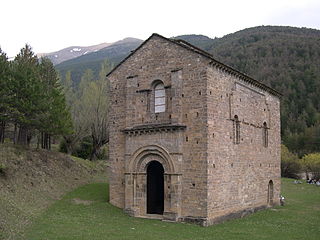
A bien de interés cultural is a category of the heritage register in Spain. The term is also used in Colombia and other Spanish-speaking countries.
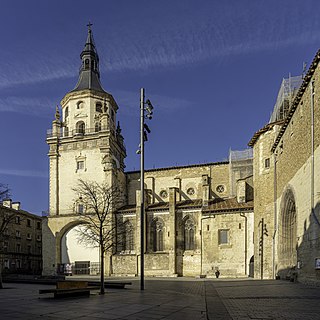
The Cathedral of Santa María de Vitoria is a Gothic-style, Roman Catholic cathedral located in Vitoria-Gasteiz, Basque country, Spain. It was declared Bien de Interés Cultural in 1931 and a World Heritage Site in 2015.
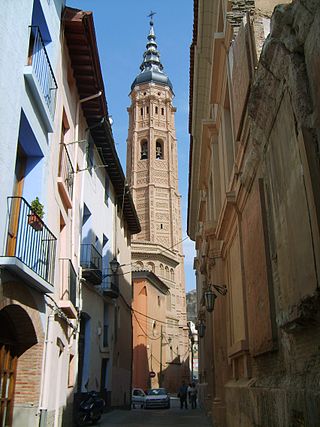
The Colegiata de Santa Maria la Mayor, in translation, the Collegiate church of St Mary Major is a mudéjar-gothic style, Roman Catholic church located in Calatayud, in Aragon, Spain.

The Church of Santa María a Real do Sar is a church located in Santiago de Compostela, Spain. It was declared Bien de Interés Cultural in 1895.The church lies on the banks of the Sar river, which flows past Santiago.
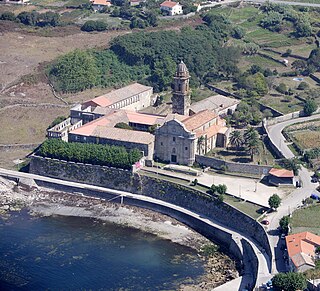
The Royal Monastery of Santa Maria de Oia is a former Cistercian monastery, founded in 1137. It is located in the province of Pontevedra, in the autonomous community of Galicia, Spain. It was declared a Bien de Interés Cultural landmark in 1931. The monastery is listed in the Register of Assets of Cultural Interest of Galicia in the list corresponding to the Province of Pontevedra, in the municipality of Oia, Spain.

The Routes of Santiago de Compostela: Camino Francés and Routes of Northern Spain is a UNESCO World Heritage Site located in Spain. It was designated in 1993, and later expanded and renamed in 2015. The complete site includes a network of five traditional pilgrimage routes of the Way of Saint James as it passes through Northern Spain: the popular French Way, the Primitive Way, the Northern or Coastal Way, the Interior Way and the Liébana Route; as well as 16 of the most "culturally significant" individual structures, including religious and civil buildings.

















